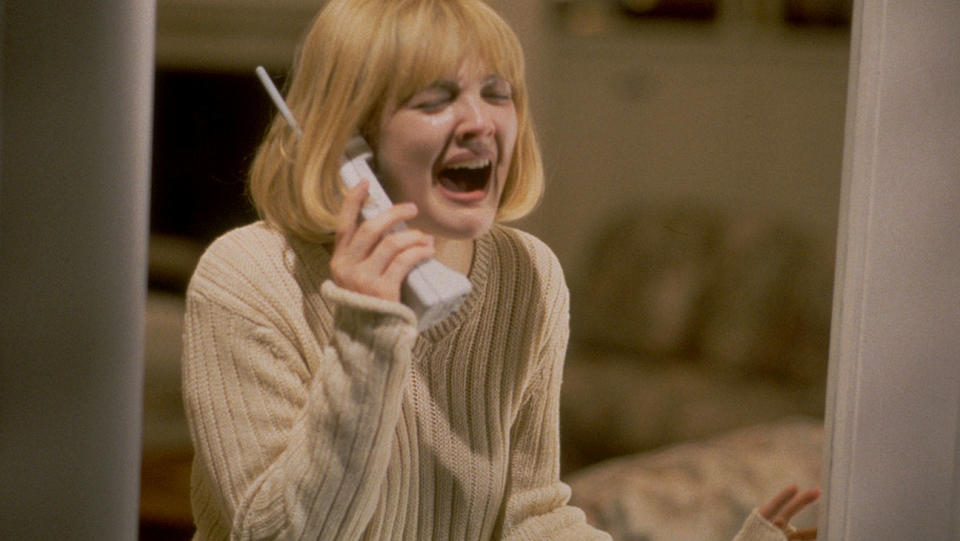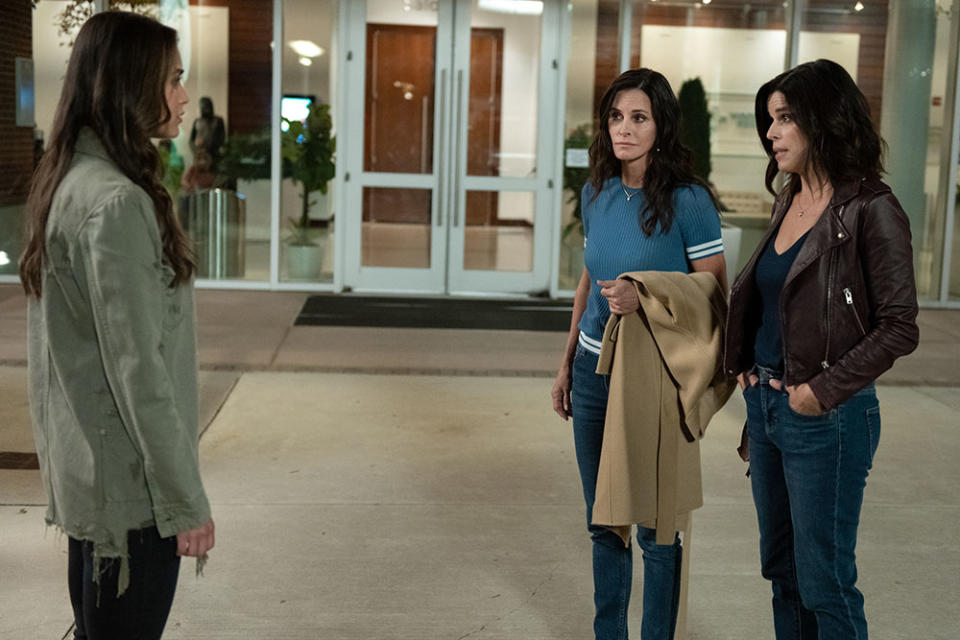‘Scream’ and the New Rules of Fandom

- Oops!Something went wrong.Please try again later.
- Oops!Something went wrong.Please try again later.
- Oops!Something went wrong.Please try again later.
[This story contains spoilers for Scream.]
Twenty-five years later and audiences still have something to scream about. Scream, the iconic slasher series created by Wes Craven and Kevin Williamson has seen its share of changes over the years: script leaks, new faces, navigating around a successful parody franchise, a TV series, the waning popularity of slasher films, and the death of the dream weaver himself, Wes Craven. Despite all of that, or perhaps because of it, Scream is back and better than ever with its fifth theatrical installment, simply titled Scream. Although Craven and Williamson are no longer the minds behind the latest sequel, directors Matt Bettinelli-Olpin and Tyler Gillett, alongside writers, James Vanderbilt and Guy Busick, manage to honor Craven’s legacy by upholding what fans have loved about the series for two and half decades, and push the franchise forward in exciting ways that once again offer sharp meta-commentary about where the horror genre is at the moment, and how the current generation of movie lovers (and haters) fit into that moment.
More from The Hollywood Reporter
Neve Campbell on 'Scream' Ending and What She Never Wants to See Happen
'Scream' Star Melissa Barrera Pulls Back Curtain on the Twist Ending
Loud 'Scream' Kicks Off Paramount's Big 2022 Theatrical Slate
It is impossible to talk about the current state of horror, which is better than ever, without diving into the current buzzword, “elevated horror.” The term has limited meaning and value, but it’s the idea that certain horror films have more artistic value, awards hopes and are smarter than what came before. Despite the term being reductive, we also all know what it means when someone says they enjoy elevated horror. It’s companies like A24, Neon, Radius-TWC and IFC Midnight, who are putting out films like It Follows (2014), The Witch (2015) and Hereditary (2018). It’s the distinction that separates something like The Babadook (2014) from Lights Out (2016) in the minds of audiences, and allows films like Get Out (2017) to break out and connect with non-horror fans and white critics with a well-recorded aversion to Blumhouse’s general horror output.
Courtesy of Paramount Pictures / Miramax, LLC
Of course, there have always been films like this, released alongside splatter sleaze, but they’ve hit mainstream, become more progressive, and emerged as many a young horror fan’s intro into the genre. Suddenly, horror movies are no longer an experience built around the deaths of characters of color, and mental illness isn’t something only found in villains, two aspects that make their way into Bettinelli-Olpin and Gillet’s new film. There is a clear difference between the characters in this latest installment, and those of Scream 4 (2011), a decade ago.
Rather than growing up with Shaun of the Dead (2004), The Hills Have Eyes (2006), Halloween (2007), and Paranormal Activity (2007) as major touchstones, these teenagers found their way into the dark with the Green Room (2015) and The Lighthouse (2019). As a result, a significant part of Scream‘s efforts is spent reminding the characters and younger audiences of the power of slasher movies, the fear and emotion that come with them. This new Scream asks its teenage characters if they like scary movies and then plays a rousing game of fuck around and find out to remind them those films they thought were corny and outdated can still cut deep.
At the same time as reminding us of the punch slasher films can offer, Scream must also navigate a territory that, now more than ever, is dominated by blockbusters. And even more than horror movies, it’s event films that make up so much of the cinematic language for Gen Z. While the box office grosses have changed, Scream has always been in tune with the larger moviegoing culture. As much as the Scream franchise, obviously, owes its biggest debt to the low-budget slasher films of the ’80s, it’s also always been in-tune with one of the world’s biggest franchises: Star Wars.
Early in Scream 2 (1997), a debate breaks out in a film class about whether sequels can top their originals. Mickey (Timothy Olyphant), who is eventually revealed to be one of that film’s Ghostface killers, says, “The Empire Strikes Back. Better story, improved special effects.” Scream‘s resident film nerd, Randy Meeks (Jamie Kennedy), who if we’re being honest doesn’t seem to know all that much about movies, retorts, “Not a sequel. Part of a trilogy. Completely planned.” Of course, as Star Wars fans know, very little of what ended up being a defining blockbuster trilogy was planned by George Lucas from the start. The same of which could be said of that initial Scream trilogy, which also offered an overtly dramatic, literally, third act showdown, complete with the revelation of family secrets. But within that brief exchange between Mickey and Randy there is this germ of an idea about the length fans will go to in order to defend the narratives they’ve created in their minds, and the minutia through which they define the worthiness of follow-ups.
Courtesy of Paramount Pictures and Spyglass Media Group
The latest film, Scream, takes that germ of an idea to its ultimate end, and once again, Star Wars is at the center of the conversation of legacy sequels and requels. Following the opening sequence stabbing of high-schooler, Tara (Jenna Ortega), and the Woodsboro slayings starting up again, this time with victims connected to characters from the previous films, Dewey Riley (David Arquette) and fresh-faced group of young adults, Sam (Melissa Barrera), Richie (Jack Quaid), Wes (Dylan Minnette), Amber (Mikey Madison), Liv (Sonia Ammar), Chad (Mason Gooding) and Mindy (Jasmin Savoy Brown), begin to break down the new rules.
Mindy, who along with her brother, Chad, are the niece and nephew of Randy from the original films, explains that they’re caught in a requel, one that appeals to nostalgia by bringing back faces from the original killings, along with new characters, who can’t be too new — thus related to previous victims and survivors. She goes on to explain that the Stab movies, based off the Woodsboro killings, took a sharp turn in Stab 8, having nothing to do with the previous murders and straying too far from the franchise’s roots. That film, which divided the Stab fandom, is said to be the work of none other than “that guy who directed Knives Out,” who we of course know is Rian Johnson, director of the incredibly divisive Star Wars: The Last Jedi (2017).
While the film doesn’t directly comment on Star Wars or The Last Jedi, it does, rightfully, mock the kinds of toxic fans who spend hours making videos about everything wrong with the movie and send death threats to the cast and crew involved. There is the pull, which we see on social media all the time, amongst those who crave new entries of their favorite franchises, but believe that they would’ve made it better, all because of the canon they’ve built up in their heads over the years. Ironically, this kind of behavior is seen less often from horror fans as it is from fans of Star Wars and superhero flicks. 2017 ended up becoming a defining year in terms of fans having a personal stake in their favorite franchises. Some of this was done with good intentions, while for others it simply became a means to exert the power they never felt they had before, or to tap into their mean streak with a sense of anonymity. This mentality isn’t too far off from the motives of the Ghostface killers in the original 1996 film. And in that same vein, it’s important that we “don’t blame the movies,” the movies just made the tactics of toxic fandom “more creative.”
The Star Wars sequel trilogy is largely responsible for the modern legacy sequel, in which older actors are brought back to share the screen with new characters in a first installment that modernizes the property but doesn’t stray too far from the original. We’ve seen this play out to varying degrees of success with Terminator: Genisys (2015), Creed (2015), Star Wars: The Force Awakens (2015), Independence Day: Resurgence (2016), Blade Runner 2049 (2017), Halloween (2018), Terminator: Dark Fate (2019), Bad Boys for Life (2020), and Ghostbusters: Afterlife (2021). And on the horizon, we have Top Gun: Maverick and Jurassic World: Dominion.
Next to building cinematic universes, legacy sequels are the hottest trend in Hollywood now. The argument could be made that Scream 4 beat the trend, despite the central commentary revolving around reboots and internet fame. Where the new Scream differs from the previous entry, is that the killers are looking to become famous as a result of the narrative they create, not, as Jill (Emma Roberts) did because of their relation to any of the previous characters or desire for fame themselves. These Ghostface killers have sacrificed their identities in service of the franchise, which feels like an honest depiction given how many Twitter accounts will make sure you know they have no lives outside of whatever movies or franchise they can’t let go of.
Scream‘s Ghostface killers (last chance to avoid spoilers) are eventually revealed to be Amber and Richie, Stab superfans, who orchestrate a scenario for the next Stab movie to adapt, one that will please disgruntled fans. This not only involves bringing back Sidney Prescott (Neve Campbell), Gale Weathers (Courteney Cox), and Dewey, but attempting to frame the daughter of the original Ghostface killer, Billy Loomis (Skeet Ulrich), with the murders in a showdown that takes place in the house once occupied by the other original Ghostface, Stu Macher (Matthew Lillard). For audiences, this interestingly becomes the plot that a number of fans were anticipating, and while Scream doesn’t subvert all expectations, as there is a formula to these things after all, it does ultimately deny power to toxic fans and place the narrative and agency back in the hands of Sam, Sidney and Gale who are free to choose who they become next. Well at least until the sequel. #RestoreRichieAmbersVision anyone?



